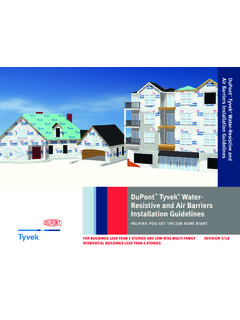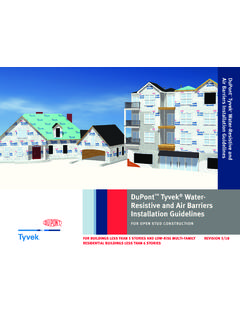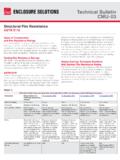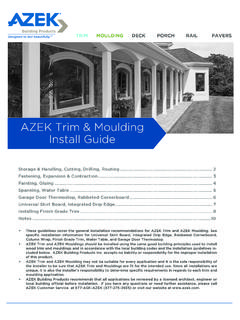Transcription of STUD SHEAR CONNECTOR APPLICATION - Fero
1 Design for Composite Structural ActionS T U D S H E A R STUD SHEAR CONNECTOR APPLICATIONCONNECTORThe innovative Stud ShearTM CONNECTOR dramatically changes typical masonry design when using light-frame structural backing such as steel stud. Because of the vertical orientation of the Stud ShearTM CONNECTOR and its consequent rigidity, the Stud ShearTM CONNECTOR is mechanically fastened to the stud framing and can resist moment at this junction. In addition, the V-TieTM is pinned at the leading edge of the Stud ShearTM CONNECTOR and rigidly embedded in the exterior masonry wythe (the veneer), both axial and vertical SHEAR forces can be resisted by the Stud ShearTM CONNECTOR to provide composite action between the exterior masonry wythe and the stud framing (forming a vertically-oriented Vierendeel truss).
2 1 All FERO masonry ties are in accordance with the following codes: CSA A370, connectors for Masonry and ACI 530/ASCE 5/TMS 402, Building Code Requirements for Masonry Structures ; CSA A370 (which references ASTM A123), ACI 6/TMS 602 (which references ASTM A153, Class B), and the International Building Code (IBC) (which reference ASTM A153, Class B), in regards to hot-dip galvanized finish for Composite Structural Action (cont.)IntroductionThe entire wall thickness, including both exterior masonry wythe and the stud framing, thereby becomes effective in resisting lateral loads. Composite action increases system stiffness, reduces lateral deflections, and increases lateral load resistance.
3 With composite structural action, the masonry wythe is no longer simply a veneer because it shares lateral load resistance with the stud framing. Consequently, it is more appropriately referred to as the exterior masonry wythe. The Stud ShearTM CONNECTOR consists of a steel Flat Plate, a V-TieTM, and an Insulation Support. Individual components are shown in Figures 1, 2 and 3; the assembly is shown in Figure 4; and the installed tie system is illustrated in Figures 5 and applied to the exterior masonry wythe are transferred through the V-Tie to the Flat-Plate, which is rigidly fastened directly to the stud framing without any intervening material such as sheathing.
4 The Flat-Plate is fastened to the side surface of the stud framing member such as a steel stud web or wood stud (see Cover illustration, and Figure 5). The holes provide a positive connection between the Flat-Plate and V-TieTM without the possi-bility of V-Tie disengagement during construction or in-service, and permits up to 63 mm ( ) of in-situ vertical adjustment so that a mortar bed joint in the exterior masonry wythe will always be coincident with the V-Tie The Stud ShearTM CONNECTOR can accommodate a range of insulation thicknesses, and is ideal for spanning large cavities, recommended for 102mm (4") and greater. The Flat Plate has sufficient length to accommodate the thickness of the cavity insulation, and further extends 18 mm ( ) into the air space to expose its leading edge and facilitate in-situ placement of the V-TieTM and Insulation Support.
5 The V-TieTM is inserted through the appropriate hole along the leading edge of the Flat Plate, and placed coincident with a mortar bed joint so as to extend horizontally and normal to the stud framing, thereby maintaining design tie capacity. The legs of the V-TieTM are positioned along the centreline of the exteriormasonry wythe within the placement tolerances permitted bythe building code having jurisdiction. Adjustment normal to the wallis facilitated by on-site selection of an appropriate length (L) ofV-TieTM (see Figure 2).2 Introduction (cont.)Components and SpecificationsThe engineered Stud ShearTM CONNECTOR is superior to multi-component ties. It offers positive restraint between tie components to prevent disengagement, reduce mechanical free play, limit deformation under load, and prevent side mounting , which places the fastener connecting the tie and structural backing in SHEAR rather than direct tension.
6 The fastener orientation and inboard position within the wall system provide a more desirable connection to the structural backing than surface-mounted tie systems which subject the fasteners to direct tension and generally higher moisture loads. Side mounting reduces the likelihood of corrosion at the fastener/structural member loads applied to the exterior masonry wythe are transferred through the V-TieTM to the Flat Plate, and by providing vertical SHEAR and bending resistance, the Stud ShearTM CONNECTOR accommodates the differential movements between the exterior masonry wythe and the stud framing. The system of Stud ShearTM connectors forms a Vierendeel truss and offers composite action between the exterior masonry wythe and the stud framing.
7 Rather than only the stud framing providing structural resistance, the entire wall thickness becomes effective in resisting lateral Plate: The Flat Plate (Figure 1) is manufactured from 16 gauge sheet steel [ mm ( ) minimum base steel thickness] and is available in both hot-dip galvanized finish and stainless steel. STUD SHEARTM CONNECTORF igure 1 Stud SHEAR CONNECTOR Flat PlateThe Flat Plate specification length, (S), refers to the actual width of the (steel) stud to which it is connected; the inboard end of the Flat Plate is intended to be installed flush with the interior flange face of the stud and the specifica-ion length, (IG) refers to the actual thickness of the insulation plus sheathing membrane plus sheathing.
8 S = Stud WidthIG = Thickness of Insulation + Membrane + SheathingP = Plate Air Space Projection3 The overall length of the Flat Plate is 18 mm ( ), (P), longer than the specification lengths (S + IG); to accommodate the length of projection into the air space to accommodate the V-Tie TM. A series of eight mm ( ) diameter holes are punched along the leading edge of the Flat-Plate to receive the V-Tie , facilitating 63 mm ( ) of construction adjustability between the Flat-Plate and the V-Tie .Holes having 12 and 25 diameter are punched through the mid-body of the Flat-Plate. When the Plate is mounted these holes are located within the cavity insulation and minimize thermal conductivity through the tie system.
9 All FERO masonry ties are thermally broken with holes to minimize thermal conductivity. Four (4) mm ( ) diameter screw holes within length , (S), of the Flat-Plate provide for plate fastening to the structural backing member. Maximum screw size is #12, use 2 per tie, recommended locations to be diagonal from each : The V-TieTM (Figure 2) is manufactured from mm ( )diameter wire and is available in both hot-dip galvanized finish andstainless V-TieTM is available in a variety of standard lengths to accommodate different specified thicknesses of exterior wythe and design widths of air space.
10 The V-Tie specification length, (L), should be selected to provide for placement of the legs of the V-Tie along the centreline of the exterior masonry wythe. Varying lengths of V-TieTM, appropriately selected by the mason on the jobsite, to accommodate construction tolerances, where the constructed width of air space differs from the design width of air space. Insulation Support: The Insulation Support (Figure 3) is manufactured from 100% recycled polyethylene.. The friction fit between the Insulation Support and the Flat-Plate restrains the insulation during construction to prevent the insulation from separating from the structural backing/ air barrier.







